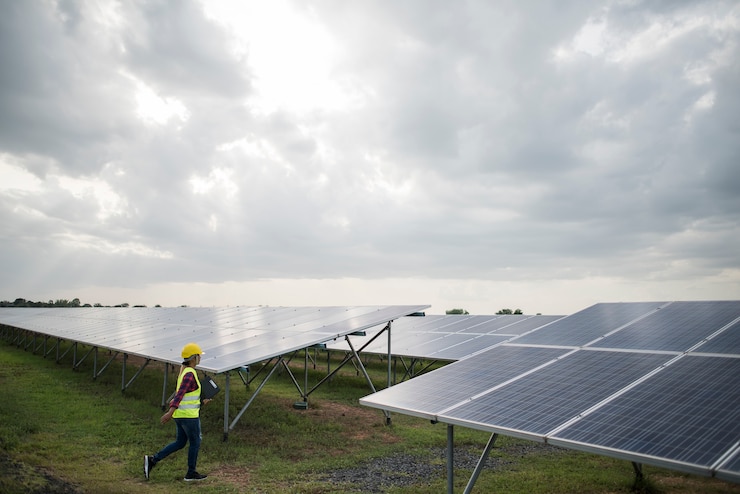Everything You Need to Know About Ground Mount Solar Plant

As businesses and homeowners seek sustainable energy solutions, solar power has become increasingly popular. Among the various solar installation options, ground mount solar plants offer a versatile and efficient alternative to rooftop installations. In this blog, we will explore everything you need to know about Ground Mount Solar Plant, including their benefits, types, installation process, and maintenance.
What is a Ground Mount Solar Plant?
A ground mount solar plant is a solar power system where solar panels are installed on the ground rather than on a roof. This type of installation is ideal for properties with ample land space and can be used for both residential and commercial applications. Ground mount systems can be customized to fit different terrains and are often used in solar farms and large-scale energy projects.
Benefits of Ground Mount Solar Plants
- Optimal Sun Exposure: Ground mount solar panels can be positioned at the ideal angle to capture the maximum amount of sunlight throughout the day. This results in higher energy production compared to rooftop installations, which may be limited by the angle and orientation of the roof.
- Scalability: Ground mount systems are highly scalable, making them suitable for large-scale solar projects. Whether you need a small system for your home or a large array for a commercial property, ground mount installations can be expanded to meet your energy needs.
- Ease of Maintenance: Maintaining ground mount solar panels is generally easier than rooftop systems. Since the panels are accessible at ground level, cleaning, inspection, and repairs can be conducted without the need for specialized equipment or safety concerns associated with working at heights.
- Minimal Roof Impact: For properties with old or structurally weak roofs, ground mount systems provide a viable alternative. Installing solar panels on the ground eliminates the need to reinforce the roof, reducing installation costs and preserving the integrity of the building structure.
- Enhanced Cooling: Ground mount solar panels often benefit from better airflow around the panels, which helps to keep them cool and maintain their efficiency. This can result in better overall performance and energy output.
Types of Ground Mount Solar Plant
- Standard Ground Mount: This is the most common type of ground mount system, where solar panels are installed on a fixed frame that is anchored to the ground. The panels are typically tilted at an optimal angle to maximize sunlight exposure.
- Pole Mount: In this system, solar panels are mounted on a single pole. It can be adjusted to change angle of panels. Pole mount systems are useful in areas with limited space or uneven terrain.
- Tracking Systems: Tracking systems are advanced ground mount installations that follow the sun’s movement throughout the day. There are single-axis trackers, which follow the sun from east to west, and dual-axis trackers, which track the sun’s movement in both horizontal and vertical directions. Tracking systems maximize energy production but are more expensive and require more maintenance.
Installation Process
- Site Assessment: The first step in installing a ground mount solar plant is conducting a site assessment. This involves evaluating the land, checking for shading obstacles, and determining the best location for the panels. Soil testing may also be conducted to ensure the ground can support the system’s structure.
- Design and Planning: Based on the site assessment, a customized system design is created. This includes determining the number of panels, the type of mounting system, and the optimal layout for maximum energy production.
- Permitting and Approvals: Before installation begins, necessary permits and approvals must be obtained from local authorities. This process can vary depending on the location and size of the solar plant.
- Foundation and Mounting: The next step is preparing the foundation and installing the mounting structure. For standard ground mounts, this involves driving posts or anchors into the ground and assembling the frame.
- Panel Installation: Once the mounting structure is in place, the solar panels are installed and secured. Electrical wiring is then connected to the inverter and other system components.
- System Testing and Commissioning: After installation, the system is thoroughly tested to ensure everything is working correctly. This includes checking the electrical connections, monitoring system performance, and making any necessary adjustments.
Maintenance and Care
Regular maintenance is crucial to keep a ground mount solar plant operating efficiently. Here are some maintenance tips:
- Cleaning: Solar panels should be cleaned regularly to remove dust, dirt, and debris that can reduce their efficiency. This can be done with water and a soft brush or using specialized cleaning services.
- Inspection: Periodic inspections should be conducted to check for any damage, loose connections, or shading issues. Promptly addressing any problems can prevent more significant issues and ensure optimal performance.
- Monitoring: Many modern solar systems come with monitoring software that allows you to track energy production and system performance. Regularly reviewing this data can help identify any issues early and ensure your system is operating at its best.
Conclusion
Overall, Ground mount solar plants offer a flexible and efficient solution for harnessing solar energy. With their numerous benefits, including optimal sun exposure, scalability, and ease of maintenance. They are an excellent choice for both residential and commercial properties. By understanding the types, installation process, and maintenance requirements, you can make an informed decision and enjoy the long-term benefits of solar power.
Read More: Upgrade Your Business with Industrial Solar Panel Company










